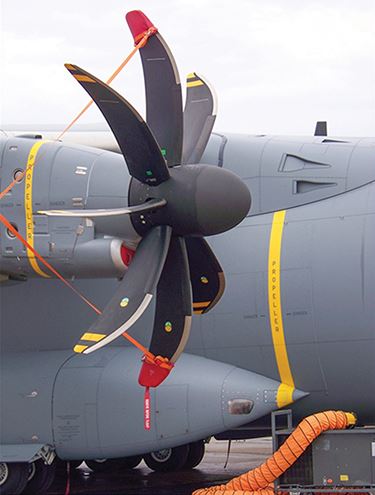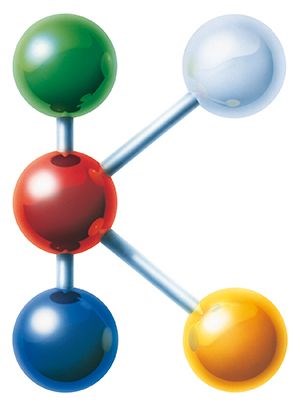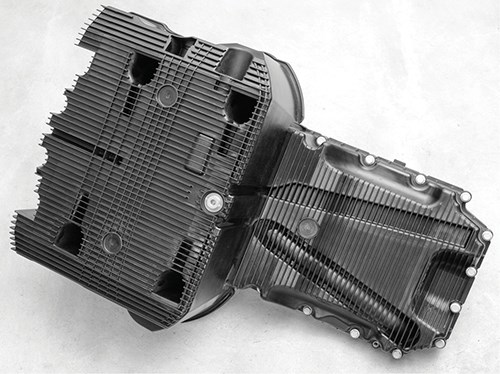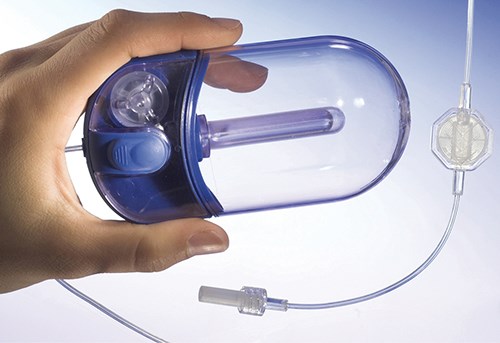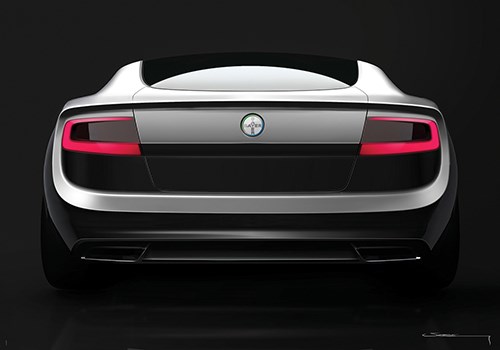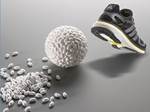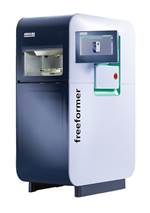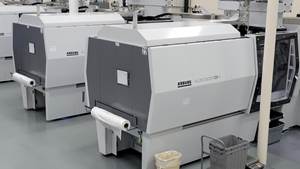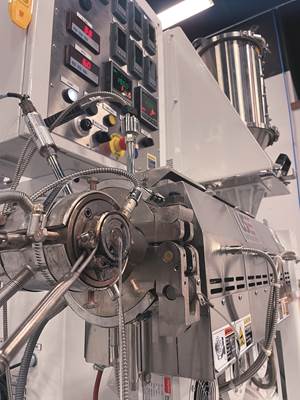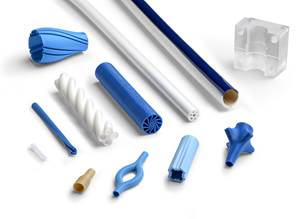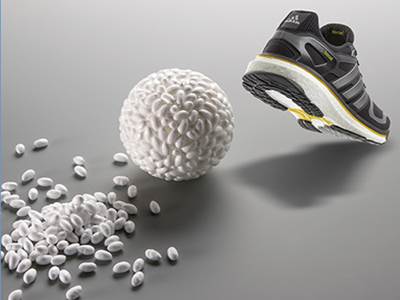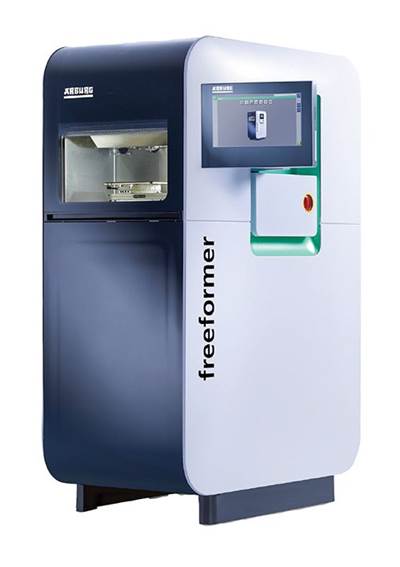Materials News at K 2013
Close Up: Materials
There was no shortage of interesting materials developments at K 2013, in particular high-performance engineering thermoplastics and thermoplastic composites—much of them geared to automotive/transportation.
There was no shortage of interesting materials developments at K 2013, in particular high-performance engineering thermoplastics and thermoplastic composites—much of them geared to automotive/transportation. We reported on some of these in last September’s show preview and in December's post-show news snapshot.. Here are more highlights in materials from October’s show in Dusseldorf.
BIOBASED ENGINEERING PLASTICS AND MORE
Solvay Specialty Polymers (U.S. office in Alpharetta, Ga.) launched a portfolio of unusual biobased nylons, revamping its Kalix HPPA (high-performance polyamide) product line and targeting structural applications for smart phones, tablets, and laptops. Included is the 3000 series, based on an entirely new molecule and said to be the industry’s first biobased amorphous polyphthalamide (PPA). Kalix 3850 and 3950 are derived 16% from sebasic acid (a renewably sourced material from Solvay Novecare). Reinforced with 50% glass fiber, they boast low shrinkage and warpage, outstanding dimensional stability with very low water absorption, and little to no flashing tendency.
Welcome! You’ve unlocked premium content.
Series 2000 is based 27% on renewable content. The line consists of semi-crystalline grades of nylon 610 with improved impact resistance and flow properties. Kalix 2855 and 2955 also boast strong mechanical properties, exceptional surface finish, and low moisture absorption.
Series 5000 extends Solvay’s halogen-free flame-retardant portfolio. Kalix 5950 is for injection molding larger structural components used in laptops and tablets that require strength, rigidity, and exceptional dimensional stability while maintaining outstanding surface quality.
Meanwhile, DuPont Performance Polymers, Wilmington, Del., showed new renewably sourced (RS) grades of Zytel 610 and 1010 resins. Low-pressure power steering lines and brake tubing made from RS 610 are just two examples of the growing demand for these materials in automotive. RS 610 can be up to 70% biobased and RS 1010 up to 100% biobased. In development is a new generations that will have higher heat resistance.
DuPont also showed a large truck oil pan of a 35% glass-filled Zytel nylon 66 that is injection molded by ElringKlinger for Mercedes-Benz. It is said to be 50% lighter than aluminum and offers a 2 db reduction in vibration noise level compared with metal.
Six new nylon 66 compounding feedstock resins were launched by Houston-based Ascend Performance Materials, geared primarily to automotive. Low-viscosity grade 21LS is designed for high flow. It enables mixing shear-sensitive materials and high filler concentrations. Two medium-viscosity resins are 21MST, which boasts excellent viscosity stability during compounding; and 21Z-NT01A2, which is highly functionalized with amine end-groups. There are also two higher-viscosity resins: medium-to-high-viscosity 52BWMS with lowest YI (yellowness index), and 65B high-viscosity grade with improved melt strength.
There is also new 88X, a medium-viscosity nylon 66 random copolymer said to have the lowest YI and good surface finish. It has melt temperature from 240 to 255 C, depending on comonomer concentration. This material has been shown to be more effective than pellet blending with nylon 6 in reducing the melt temperature without decreasing the desired mechanical properties.
Evonik Industries (U.S. office in Parsippany, N.J.) discussed its developmental Trogamid RS6121, a highly transparent nylon that can withstand high temperatures. It is based on new monomers and paves the way to applications previously reserved for polysulfones because of heat-resistance requirements. It boasts a dry glass-transition temperature (Tg) about 30° C higher than Trogamid CX transparent nylons, allowing for a higher continuous-use temperature. It withstands steam sterilization at 134 C and is said to open new applications in medical, electrical, automotive, and mechanical engineering markets. Due to its significantly reduced water absorption of less than 2%, the Tg does not fall below 134 C.
DSM Engineering Plastics (U.S. office in Birmingham, Mich.) showcased oil sumps developed for Peugeot and Daimler and made with 35-50% glass-filled Akulon Ultraflow nylon 6. They are 60% lighter than their metal counterparts, yet equally impact resistant. DSM also highlighted its biobased EcoPaXX nylon 410, which has moved from sports and leisure applications to automotive when combined with 35% glass fiber. It was used for the engine cover of the new Mercedes-Benz A-class as well as the crank shaft of a new generation of fuel-efficient engines from Volkswagen, resulting in weight savings of 35-50% vs. the metal it replaces.
Solvay Engineering Plastics (U.S. office in Alpharetta, Ga.) introduced Technyl eXten metal-coating grade of biobased nylon 610 that can be used to replace copper with aluminum in heat exchangers and refrigerant pipe.
Celanese (U.S. office in Florence, Ky.) launched Fortron ICE 504L, a “next-generation” PPS that meets UL 94V-0 at 0.38 mm and is said to open new end-uses in automotive, electrical/electronic, aerospace, fluid handling, and other markets due to improved properties and processing characteristics vs. standard PPS. Injection molding field trials reportedly demonstrate that Fortron ICE specialty grades can reduce cycle times, scrap rates, and overall costs, and also improve flatness and enable easier demolding.
Also new from Celanese is glass-reinforced Hostaform XGC series acetal copolymers for structural applications, such as window lift plates, gears, and motor housings used in a variety of industries. Compared with typical glass-reinforced acetals, new grades XGC10 and XGC25 (10% and 25% glass, respectively) boast 10% better tensile strength at break, 130% improvement in Charpy impact strength, and 60% higher Charpy notched impact.
Bayer MaterialScience (U.S. office in Pittsburgh) highlighted mobile drug-metering units as outpatient treatment systems that can be worn on the body or clothing. The company has been working on these applications with medical OEMs using its PC-based resins. One example is a small mechanical injection pump that allows patients to administer their own medicines with high dosing accuracy; it is made from highly lipid-resistant, sterilizable, and biocompatible Makrolon Rx PC. Another case is an insulin pen made of Bayblend M850XF PC/ABS that allows for injection molding such thin-walled parts.
Sabic Innovative Plastics, Pittsfield, Mass., showcased its Lexan XHR sheet portfolio, including its new super-low-gloss XHR6005 and XHR5000 coextruded sheet. They reportedly allow weight reductions of up to 12% vs. typical PVC/acrylic products, delivering improved fuel economy, while complying with OEM material specifications for aircraft parts and FST (flame, smoke, and toxic gas) requirements of major airlines for interior components such as seating, cockpit linings, door shrouds, and window surrounds and shades. It can be color-matched in sheet and resin form for coordinated thermoformed and injection molded parts. Also new is XHR A13 film, which is said to add robustness to multilayer laminate constructions used in decorative interior applications.
Sabic also highlighted its contribution to what is said to be the world’s most fuel-efficient production car—Volkswagen’s XL1 diesel plug-in hybrid vehicle. VW is the first OEM to adopt two-component injection molding for the side windows of a passenger car, using Sabic’s proprietary Exatec plasma-coating technology on Lexan PC resin and Cycoloy PC/ABS.
Several other high-performance nylons, PET compounds, PC and acetal resins were also showcased by BASF, Lanxess, DuPont, and DSM as reported in September and December.
THERMOPLASTIC COMPOSITES
As reported in our December Starting Up section, Solvay Specialty Polymers announced its entry into thermoplastic composites at the show through a minority investment in Canada’s Aonix Advanced Materials Corp., which was finalized last month. Aonix offers proporietary TP composite prepregs and equipment for automated parts manufacturing. Aonix’s developments to date have focused on high-end materials such as PEEK and polysulfones.
The new partnership provides Aonix with access to Solvay’s extensive portfolio of plastics to help expand the range of applications for customers of Aonix’s UltraMaterial Solution, which is a novel turnkey program ranging from part design, material formulation, and prepregs to building molding or thermoforming machines for mass production of high-performance composites. Initial target markets will be E/E applications followed by sporting goods, aircraft, and automotive.
Celanese highlighted the new Airbus A400M military transport aircraft, which features its Fortron PPS incorporated into a glass fabric by TenCate Advanced Composites. Germany’s Fokker Aerostructures processes the material into finished panels that protect sides of the fuselage alongside the propeller tips from damage caused by ice chunks flung from the propellers. The glass-reinforced material, which was chosen for its excellent impact performance, is also being used on the fixed-wing leading edges of the Airbus A380.
Celanese also highlighted a cost-effective process to manufacture lightweight aerospace components developed by Germany’s Faserinstitut Bremen e.V (FIBRE). These use a continuous fiber-reinforced structural inlay based on Fortron PPS. In a pilot-project, FIBRE made aircraft window frames using a thermoforming and injection molding process that competes with thermoset prepreg and RTM processes that require long cure times.
Bayer MaterialScience showed some prototype structural components on a new concept car, including a Class-A trunk lid with a sandwich structure. Its two outer layers are made of continuous-glass mats impregnated with a special Makroblend PC/PBT formulation with viscosity adjusted to ensure complete wetting of the fibers to achieve high stiffness of the edge layers. This is a melt-impregnation and extrusion process similar to crosshead extrusion. The skin is thermoformed and then bonded with a low-density PUR foam core. Glass fiber can be unidirectional or cross-directional tape or unidirectional sheets.
Lanxess (U.S. office in Pittsburgh) exhibited an instrument-panel support that uses an intriguing variant of plastic-metal hybrid technology developed with an undisclosed partner. Lanxess said the part is made with a tube or duct of aluminum that is deformed in the mold with high pressure, and then overmolded with a nylon 6 reinforced with 60% short glass fibers.
Also showcased by Lanxess was the new Opel Astra OPC car seat shell made from its Tepex continuous-glass reinforced TP composite, which boasts a 45% weight savings. Tepex dynalite 102-RG600(2)/47% has a nylon 6 matrix reinforced with 47% continuous glass fibers in two layers. The part is made with a cost-efficient one-shot process: The composite sheet is heated and then placed in an injection mold. It is pressed into shape and immediately overmolded with nylon 6 filled with short glass fibers to integrate reinforcing ribs and mounting points.
Meanwhile, DSM officials confirmed that the company is launching a range of carbon-fiber composites with its biobased EcoPaXX nylon 410, as well as Akulon nylon 6 and Stanyl nylon 46, to reduce weight in body and chassis parts. Housing covers, fuel locks, and structural beams are all in development with partners. Glass-reinforced composites are also being developed for reducing weight of semi-structural components.
A week after the show, DSM announced that it had joined the LIPA-Team (Lightweight Integrated Process Application), to develop an industrial process for manufacturing endless-fiber thermoplastic composite parts, for which the company is expected to contribute its expertise in nylon 6. The LIPAseries Project Team, whose lead partner is Georg Kaufmann Formenbau in Switzerland, has developed an integrated process that involves preheating an organic sheet (thermoplastic-impregnated continuous fibers), transporting it robotically to the LIPA tool in an injection machine, and overmolding it with thermoplastic to create the final part.
Meanwhile, Sabic officials confirmed that the company’s carbon-fiber project is under way in Saudi Arabia and will be used for development of both thermoplastic and thermoset composites. Nearly three years ago, the company formed an agreement with Italian acrylic fiber producer Montefibre SpA, which granted Sabic an international license for Montefibre’s carbon-fiber technology. Other companies with significant advances in thermoplastic composites, as we reported in September, include BASF and Victrex.
NEW EXTRUSION GRADES
Topas Advanced Polymers, Florence, Ky., launched a new film extrusion grade of its cyclic olefin copolymer (COC) that is said to deliver a unique combination of greater heat stability and robust extrusion performance. Topas 7010F-600 features an HDT of 100 C for multilayer food packaging that withstands hot-fill conditions. The material is also said to offer excellent hot-tack properties for better sealing.
For water pipe, Borealis (U.S. office in Rockport, N.J.) introduced BorSafe ME3440-D MDPE (PE80) and HE3490-DS-H high-density (P100) resins, which exhibit higher resistance to chlorinated disinfectants. Pipes based on these materials, made with Borstar bimodal technology, have shown in trials to last at least three times longer than typical PE100 pipes, and are expected to enhance the quality of drinking water in demanding chlorinated disinfection conditions.
Celanese launched the first new GUR UHMW-PE in nearly 60 years, made with what is called “breakthrough’” technology that is said to provide a step change in both material performance and processing efficiencies. One test application offers improved puncture strength and greater design freedom for membranes and separators used in lithium-ion batteries. The new material also is said to offer significantly higher abrasion resistance to extend life of machined parts while retaining impact performance. Trial samples will be available in the second half of this year.
Related Content
Consistent Shots for Consistent Shots
An integral supplier in the effort to fast-track COVID-19 vaccine deployment, Retractable Technologies turned to Arburg and its PressurePilot technology to help deliver more than 500 million syringes during the pandemic.
Read MoreCatheter Specialist Finds Sweet Spot Serving Small, Medium-Sized Concerns
Medical-component specialist LightningCath has carved a niche meeting the needs of small to medium-sized entrepreneurs with complex catheter designs … quickly.
Read More3D Printed Spine Implants Made From PEEK Now in Production
Medical device manufacturer Curiteva is producing two families of spinal implants using a proprietary process for 3D printing porous polyether ether ketone (PEEK).
Read MoreDuPont Buys Medical Product Manufacturer Spectrum Plastics
Purchase price of $1.75 billion for leading supplier of extruded, molded, and 3D printed medical components.
Read MoreRead Next
K 2013 Preview: Materials & Additives
The K 2013 show will present a broad range of engineered plastics materials, including thermoplastic composites, as well as additives. Automotive and electronic applications will be the main targets, as well as medical, packaging, lighting, and construction.
Read MoreHeadlines from the K 2013 Show
Here’s just a taste of the innovations on display, a selection of the top headlines not covered in our September show preview.
Read MoreSee Recyclers Close the Loop on Trade Show Production Scrap at NPE2024
A collaboration between show organizer PLASTICS, recycler CPR and size reduction experts WEIMA and Conair recovered and recycled all production scrap at NPE2024.
Read More

